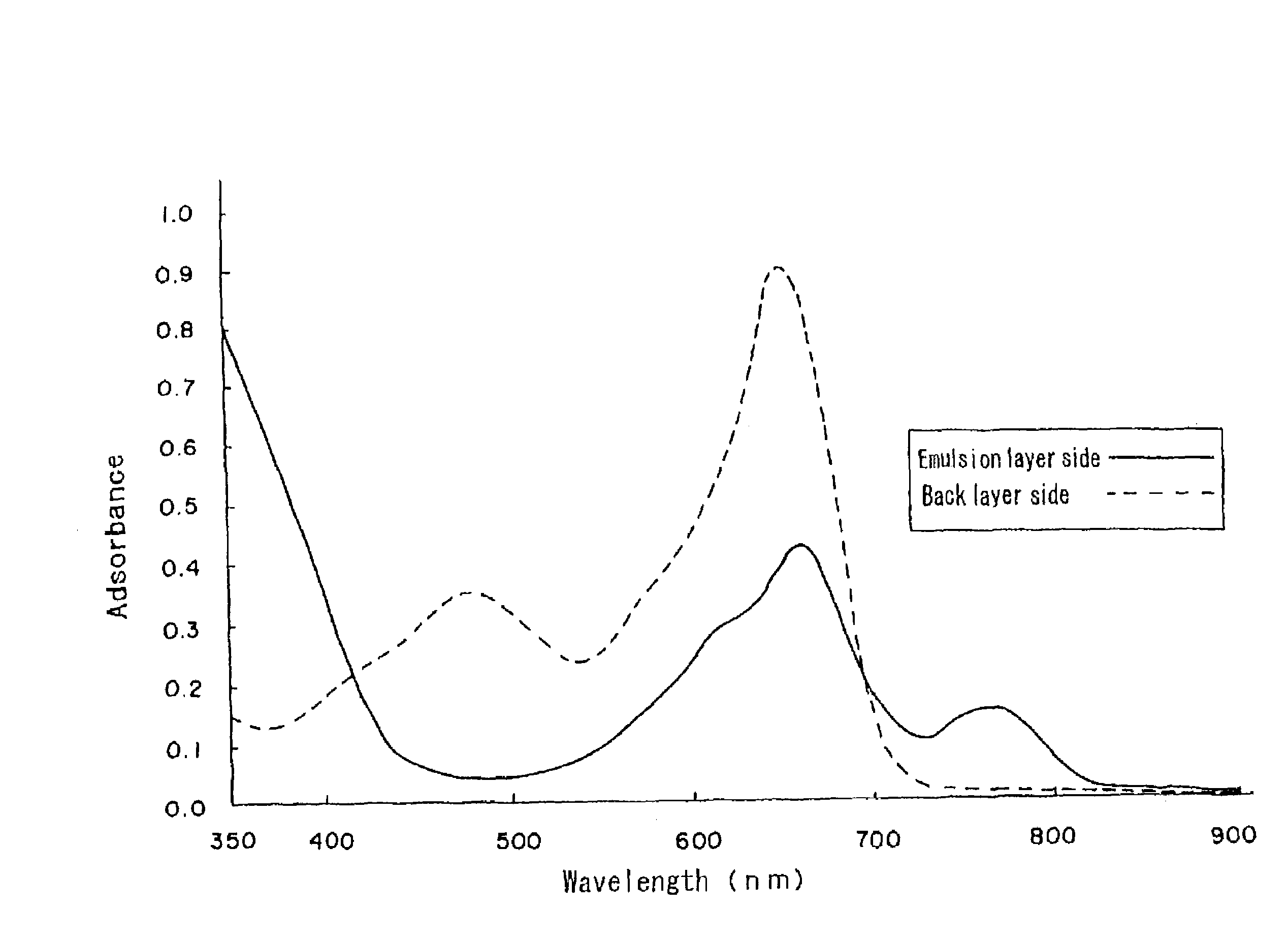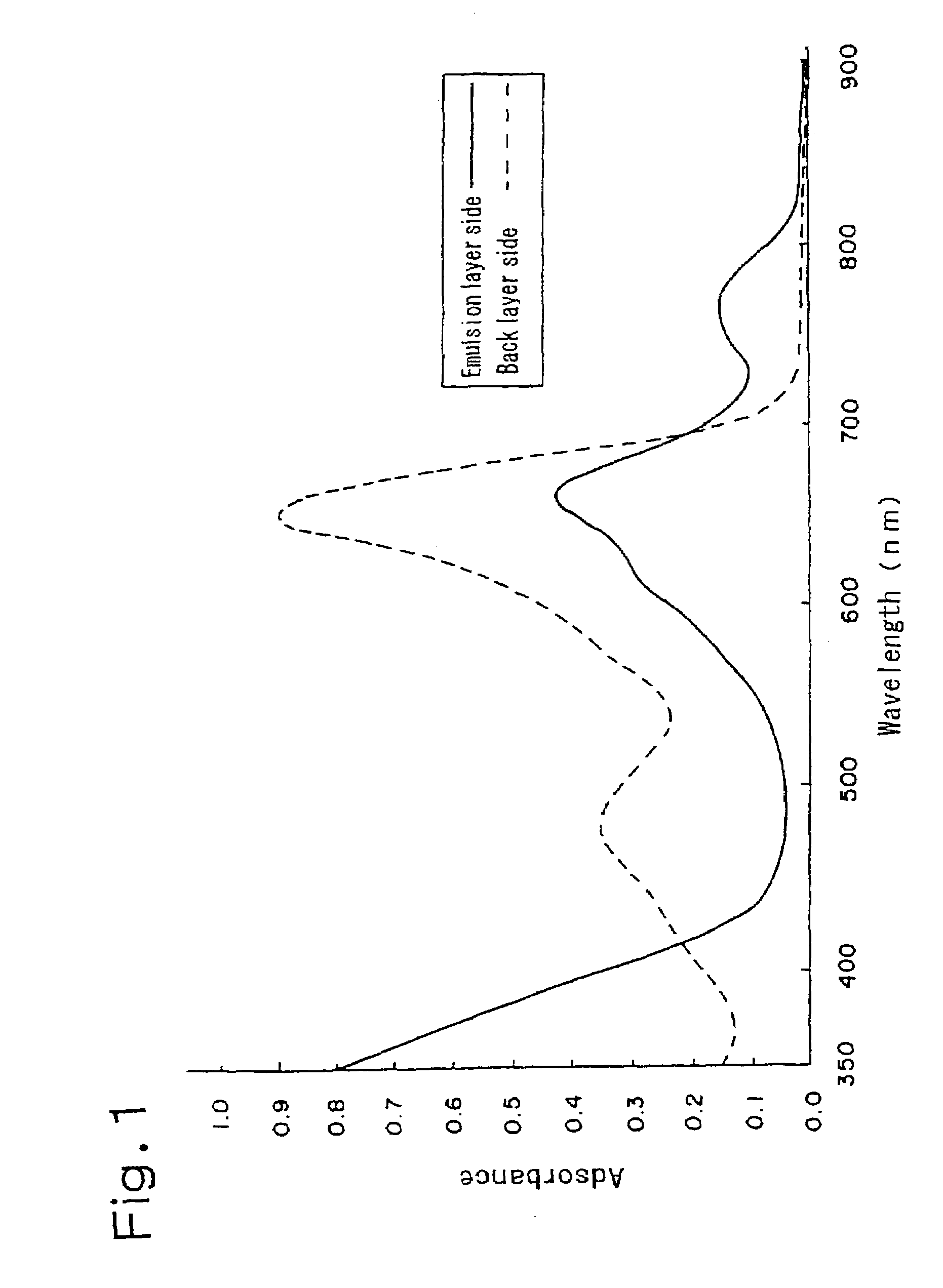Silver halide photographic light-sensitive material
a silver halide, light-sensitive technology, applied in the direction of photosensitive materials, auxiliaries/base layers of photosensitive materials, instruments, etc., can solve the problems of air oxidation, instable, fluctuation of sensitivity, etc., and achieve good storage stability and high sensitivity
- Summary
- Abstract
- Description
- Claims
- Application Information
AI Technical Summary
Benefits of technology
Problems solved by technology
Method used
Image
Examples
example 1
[0254]In this example, silver halide photographic light-sensitive materials satisfying the requirements of the present invention (Samples 10 to 15 and 23 to 39) and comparative silver halide photographic light-sensitive materials (Samples 1 to 9 and 16 to 22) were prepared and evaluated. Production methods of emulsions and non-photosensitive silver halide grains used for the production of those silver halide photographic light-sensitive materials will be explained first, and then the method for producing the silver halide photographic light-sensitive materials and evaluations of them will be explained.
>
[0255]
Solution 1Water750 mLGelatin 20 gSodium chloride 3 g1,3-Dimethylimidazolidine-2-thione20 mgSodium benzenethiosulfonate10 mgCitric acid0.7 g
[0256]
Solution 2Water300 mLSilver nitrate150 g
[0257]
Solution 3Water300 mLSodium chloride38 gPotassium bromide32 gK3IrCl6 (0.005% in 20% KClAmount shown inaqueous solution)Table 1(NH4)3[RhCl5(H2O)] (0.001% in 20% NaClAmount shown inaqueous so...
example 2
[0332]Samples were prepared in the same manner as in Example 1 except that each of carboxymethyltrimethylthiourea compound or dicarboxymethyldimethylthiourea compound, which are tetra-substituted thiourea compounds, was used instead of the sodium thiosulfate used for chemical sensitization of Emulsion A in Example 1 in the same molar amount as the sodium thiosulfate. The samples having the characteristics of the present invention showed good performances as in Example 1.
example 3
[0333]The same experiment as that of Example 1 was performed by using Developer (A) and Fixer (B) mentioned below. As a result, the samples having the characteristics of the present invention showed good performances as in Example 1.
Developer (A) [Composition Per Liter of Concentrated Solution]
[0334]
Potassium hydroxide60.0gDiethylenetriaminepentaacetic acid3.0gPotassium carbonate90.0gSodium metabisulfite105.0gPotassium bromide10.5gHydroquinone60.0g5-Methylbenzotriazole0.53g4-Hydroxymethyl-4-methyl-1-phenyl-2.3g3-pyrazolidoneSodium 3-(5-mercaptotetrazol-1-yl)-0.15gbenzenesulfonateSodium 2-mercaptobenzimidazole-5-0.45gsulfonateSodium erysorbate9.0gDiethylene glycol7.5gpH 10.79
[0335]Upon use, a mother solution was prepared by diluting 2 parts of the above concentrated solution with 1 part of water. The mother solution showed pH of 10.65. A replenisher was prepared by diluting 4 parts of the above concentrated solution with 3 parts of water. The replenisher showed pH of 10.62.
[0336]
Fixe...
PUM
| Property | Measurement | Unit |
|---|---|---|
| optical density | aaaaa | aaaaa |
| pH | aaaaa | aaaaa |
| pH | aaaaa | aaaaa |
Abstract
Description
Claims
Application Information
 Login to View More
Login to View More - R&D
- Intellectual Property
- Life Sciences
- Materials
- Tech Scout
- Unparalleled Data Quality
- Higher Quality Content
- 60% Fewer Hallucinations
Browse by: Latest US Patents, China's latest patents, Technical Efficacy Thesaurus, Application Domain, Technology Topic, Popular Technical Reports.
© 2025 PatSnap. All rights reserved.Legal|Privacy policy|Modern Slavery Act Transparency Statement|Sitemap|About US| Contact US: help@patsnap.com



